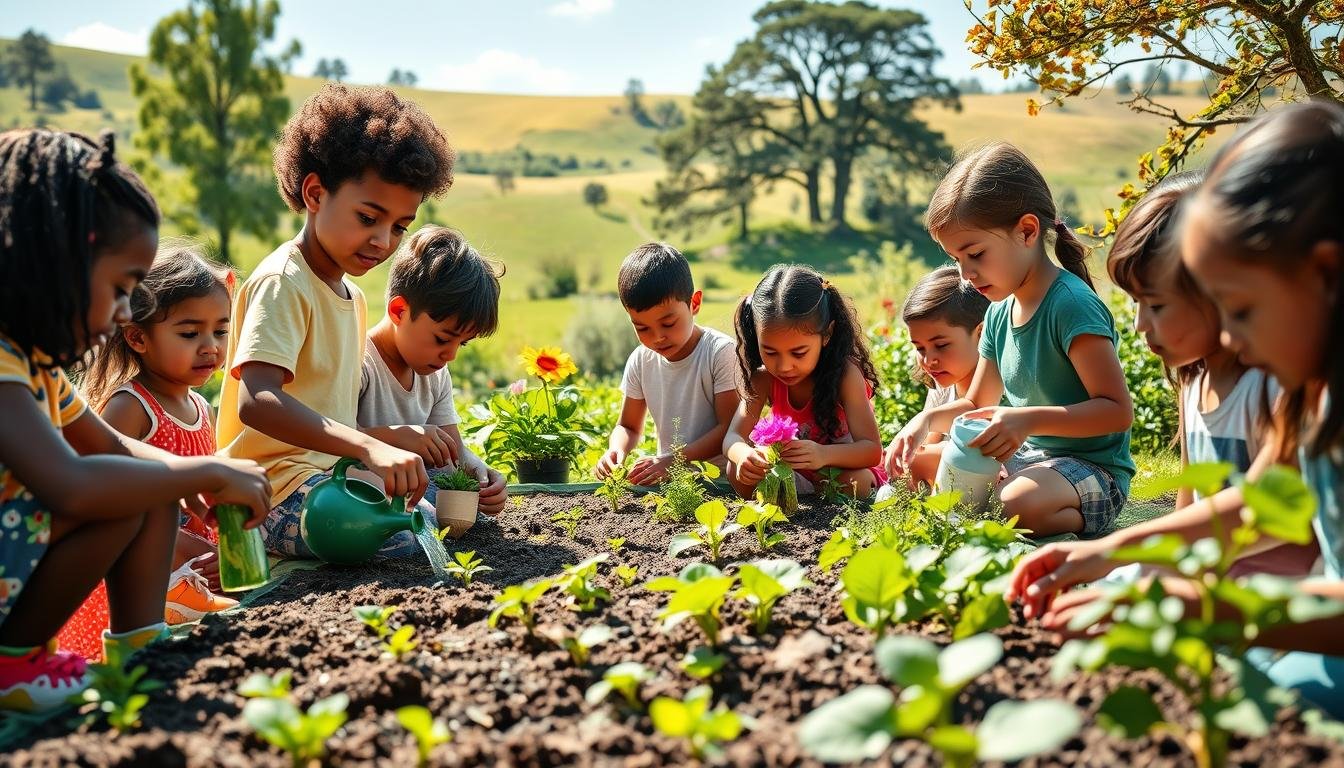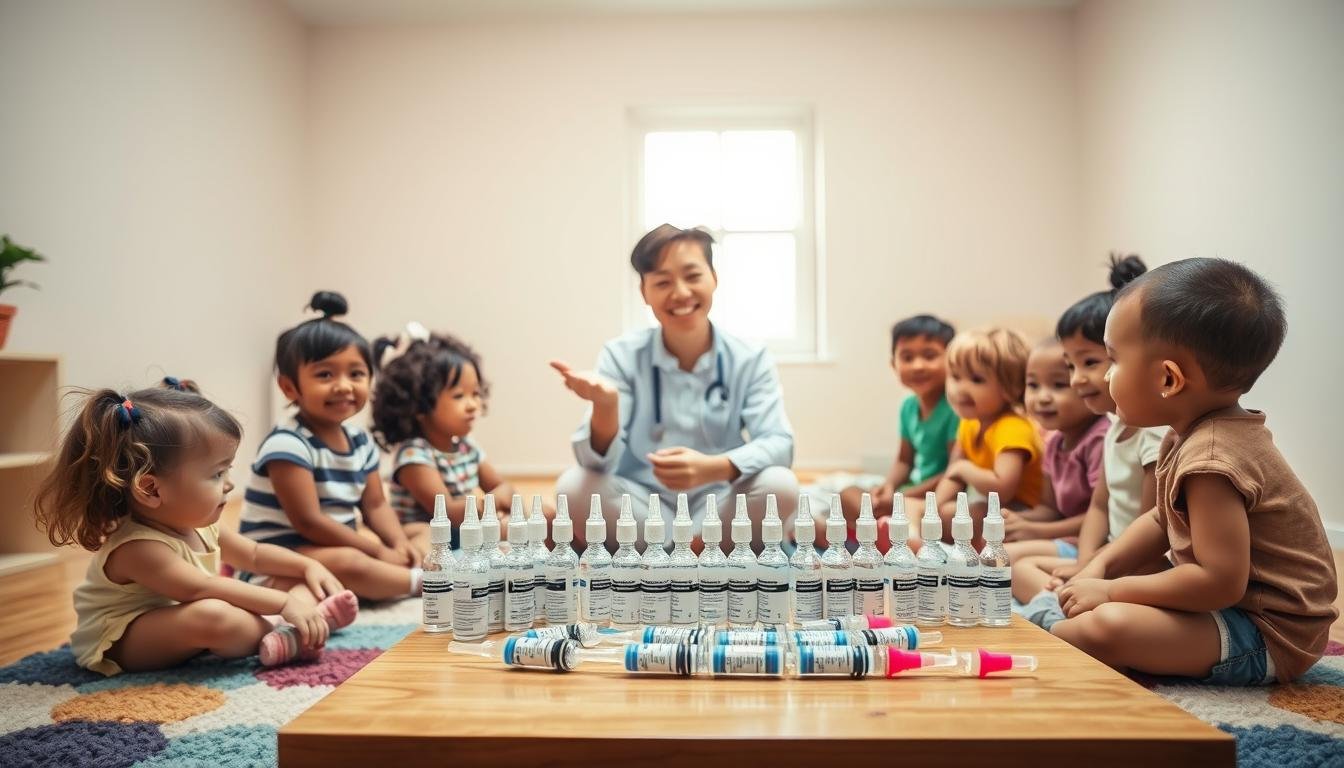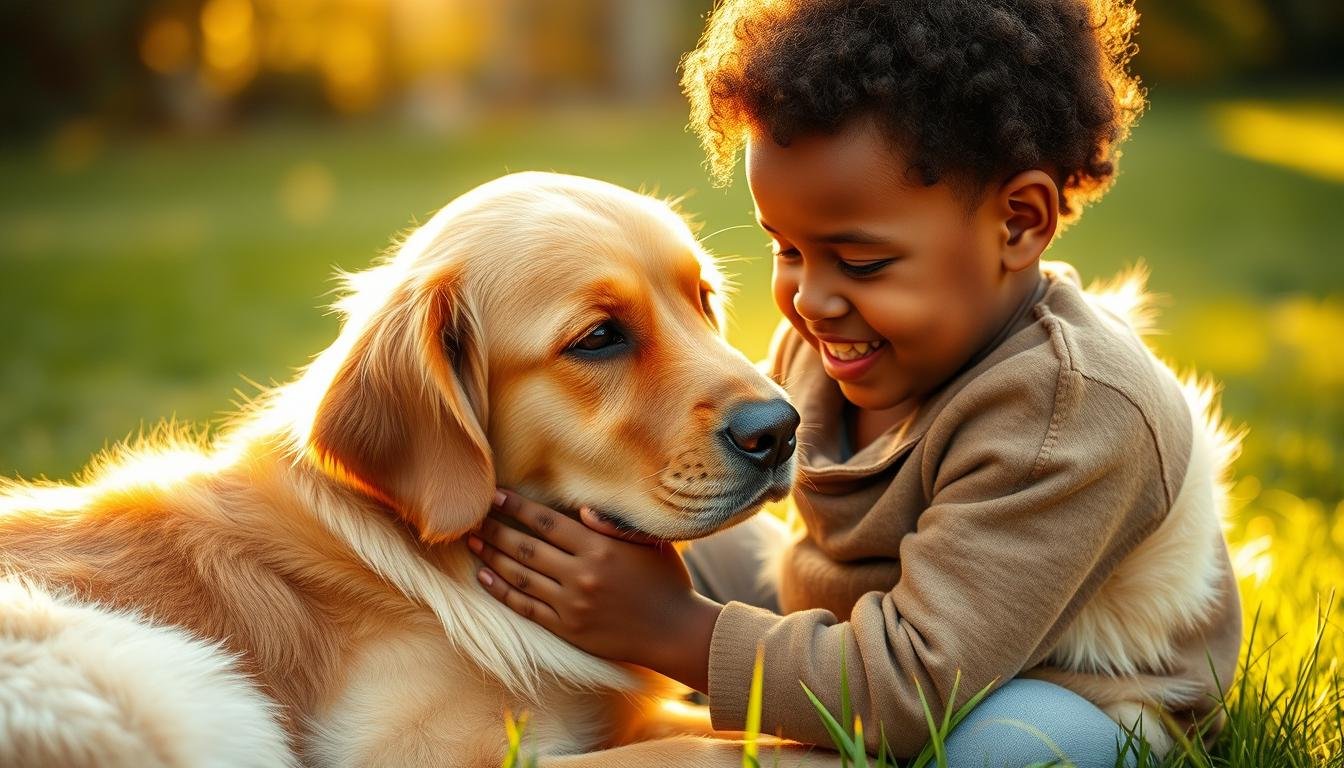Have you thought about how gardening helps kids more than just for fun? It’s a way to help them grow, both in nature and in skills. Gardening projects for kids can improve the little muscles in their hands. This is important as they learn to connect with the earth.
Picture your child carefully holding a small plant or softly pressing seeds into the earth. These simple garden tasks are like a workout for their fingers. They help with skills needed for writing, making things, and taking care of themselves. Join us and your child in a gardening adventure. It’s not just about seeds. It’s about growing strong and skilled for life’s adventures.
Introduction to Gardening with Kids
Introducing kids to gardening is about more than just planting seeds. It’s about teaching them to care for nature. They learn the benefits of gardening for kids, which helps them grow in many ways. These gardening activities make them curious and meet their learning needs. They also help kids feel connected to the natural world.
Gardening helps kids grow in many ways. It’s a fun way to learn outside. Through child-friendly gardening activities, kids become responsible by taking care of plants. They touch and smell different plants, which helps their brains grow. This also makes them stronger as they dig and move around the garden.
Explore the benefits of gardening for kids more deeply. Find activities that improve important skills. For instance, dealing with small seeds teaches kids to be careful and patient. These skills are very important for their growth.
| Activity | Skills Enhanced | Recommended Plants |
|---|---|---|
| Planting Seeds | Fine Motor Development, Patience | Tomatoes, Carrots |
| Creating a Pizza Garden | Creativity, Planning | Basil, Tomatoes, Peppers, Oregano |
| Making a Butterfly Garden | Environmental Awareness | Lavender, Zinnias, Marigolds |
Gardening teaches kids important life skills. They learn about taking care of living things. Gardening helps them develop patience, creativity, and responsibility. These skills are very important for kids’ overall growth. This shows how valuable gardening can be for them.
Gardening Projects for Kids to Enhance Fine Motor Skills
Gardening with kids is more than just about plants. It’s a great way to improve their fine motor skills. It offers fun and beneficial activities. Kids use their hands in different ways, like placing tiny seeds or moving young plants. This helps strengthen their hand and finger muscles.
In kids’ gardening activities, children grow in more ways than one. They learn patience and how to be responsible. Tasks like planting need them to be precise and careful. This helps their fine motor skills get better. It’s a learning experience that keeps them busy and teaches them valuable lessons.
- Planting seeds: Needs careful handling, which is great for their dexterity.
- Transferring seedlings: Boosts sensory skills with precise movements.
- Pruning and weeding: Improves how they coordinate their hands and eyes.
Gardening projects for motor skills do more than teach; they empower kids. Each effort in the garden helps them grow in skill and confidence. So, let’s get those gardening gloves on. Let’s help our kids flourish, in the garden and in their skills!
Starting with Seeds: A Guide for Young Gardeners
Seed planting for kids should be simple and fun. We select seeds like beans and sunflowers that are easy for small hands. This makes them great for kids learning about gardening. It helps grow their curiosity and confidence.
Our gardening seed guide suggests hands-on teaching. After starting with bigger seeds, kids move to smaller ones. This teaches them about seed spacing and how deep to plant them.
- Starting with easy-to-handle seeds helps build initial confidence and interest.
- Skills such as placing seeds at the correct depth and distance can be honed with smaller seeds.
- Observing the growth of the plants they’ve planted deepens children’s connection to nature.
Planting seeds teaches kids patience as they wait for growth. It’s a chance to teach them about plant life cycles. They learn by doing, which enhances their education.
Getting children involved in planting is valuable. They feel proud watching seeds grow into plants. This inspires them to keep learning about gardening.
Transplanting Seedlings with Care
Transplanting for kids is a big step in teaching them about care and responsibility. It combines fun with learning, teaching them patience and attention to detail. Through gentle handling of seedlings, kids learn how precious life is and the importance of caring for plants.
Transplanting means moving a plant to a new spot, like into the garden. It’s important to be gentle so the roots and shoots don’t get hurt. Kids learn to ready the soil, dig the right-sized holes, and place their plant babies carefully.
This hands-on method shows the importance of careful movements and how they affect a plant’s growth. It also lets caregivers talk about how plants grow, making the lesson even richer.
Here’s a simple table to help you and your young gardeners understand the basic steps in safe seedling transplantation:
| Step | Description | Tips |
|---|---|---|
| 1. Prepare the New Home | Loosen the soil and add compost if needed. | Make sure the soil is moist and soft. |
| 2. Remove the Seedling Gently | Carefully take the seedling out of its current container. | Support the root ball to prevent damage. |
| 3. Transplant | Place the seedling in the prepared hole and fill with soil. | Do not bury the seedling too deep; keep the stem at soil level. |
| 4. Water Generously | Water the area to help settle the soil around roots. | Use a gentle spray to avoid washing out the soil. |
In conclusion, transplanting for kids is more than just moving plants. It’s a chance to teach them about nature, care, and patience. Demonstrating these techniques helps grow both beautiful gardens and thoughtful minds.
The Art of Watering: Tools and Techniques for Young Gardeners
Teaching kids to water plants is crucial in gardening. It lets young gardeners learn about plant lifecycles. It also builds their sense of care for the environment. Using kid-friendly watering tools is key. These tools are safe and right for small hands.
To start, show kids how to check the soil moisture before watering. This saves water and teaches them about plants’ needs. A simple method is the finger test—putting a finger into the soil to see if it’s dry. This method is fun and teaches kids how nature works.
- Teach the basics of holding a watering can and managing the water flow.
- Instruct them to aim water at the plant’s base to prevent disease.
- Explain the best times for watering plants. Early morning or late evening is best.

Kid-friendly watering tools make gardening fun and safe. Lightweight, colorful watering cans or spray bottles are great for kids. They can help without using heavy equipment. This is good for their growth and learning about taking care of the earth.
It’s also good to tell stories about the role of water in life. This makes kids feel a connection to watering. They will keep an interest in gardening. Such practices teach kids to care for our planet. They start learning with their backyard or a community garden.
Teaching kids about watering plants is more than a simple task. It’s about giving them the tools and knowledge to grow. Just like the plants they look after, these lessons are important. They help kids develop a caring and active view on life and nature.
Gardening Tools for Kids: Safe and Effective Options
It’s vital to choose kid-safe gardening tools when letting kids explore the garden. These tools are made for younger users, keeping them safe and interested in gardening. By picking the right tools, kids can enjoy gardening more. This also helps them grow physically and learn new things.
Kid-safe gardening tools are designed to be light and have rounded edges. They also fit nicely in small hands. This makes it easier and safer for kids to garden. It also helps them improve their motor skills. Let’s look at some great tools for young gardeners.
- Small Hand Trowels: These are great for making small holes for seeds or moving small plants.
- Child-sized Rakes: They’re good for spreading soil or mulch. They also teach about preparing the land for plants.
- Watering Cans: Made with easy-to-hold handles and lighter materials, kids can easily water plants with them.
- Gardening Gloves: They keep little hands clean and safe from scrapes.
- Bucket Sets: Kids can use them to pick weeds, move soil, or keep their tools together.
Each tool is important for a child’s gardening kit. Giving kids tools made for them enhances their gardening skills. It also makes them more confident and interested. Plus, using tools that fit them teaches responsibility and pride in their work.
Using kid-safe gardening tools makes gardening tasks easier for children. It keeps activities fun and approachable. This approach matches our goal to create a supportive learning space. Here, kids can connect with nature and learn from it.
Soil Exploration: Mixing, Digging, and Fertilizing
Hands-on activities are key to our children’s growth. That’s why soil exploration matters. It teaches kids about their surroundings and improves their physical skills. These activities are crucial in gardening education.
Digging and fertilizing offer more than fun; they’re key learning opportunities. Kids learn about different soils by digging, sparking curiosity. This curiosity encourages a love for science and nature.
- Mixing soil with compost shows them how plant growth depends on nutrients.
- Digging enhances motor skills by teaching them to use tools and manage strength.
- Fertilizing explains how to support growth and sustain ecosystems.
These tasks teach kids about the environment and the need to protect it. They learn how everything in nature is connected and why it’s important to care for our planet.
As kids mix, dig, and fertilize, they get stronger and more coordinated. Seeing the results of their efforts, like seeds sprouting, motivates them. It shows how rewarding gardening can be.
Helping kids with gardening teaches them its importance. It connects them to soil projects. And it makes them feel proud and responsible for nature.
So, let’s start gardening with our kids. It’s good for their growth and for a healthier planet. Learning through gardening is a valuable gift for their future.
Crafting and Using Plant Labels for Educational Fun
Making plant labels with kids is both fun and educational. It’s way more than playing in dirt. Designing and placing these labels helps children learn in many ways.
Kids can improve their reading and writing by labeling plants with their names and how to care for them. They learn about plants and the environment, which helps them respect nature.
- Practical literacy skills are enhanced as kids write out labels.
- Scientific knowledge grows as they learn why certain plants need more sunlight or water.
- Creative expression is encouraged through decorating and personalizing their plant labels.
This hands-on learning is key for remembering what they learn. It sparks interest in gardening. While making labels, kids use critical thinking and problem-solving. This makes learning fun and stays with them forever.
Harvest Time: Encouraging Patience and Rewarding Effort
Gardening projects climax with the harvest moment, especially when kids are involved. This isn’t just about picking fruits or vegetables. It teaches them patience. Seeing seeds turn into ripe plants is rewarding. As you pick the produce with your children, think about how this shows them where food comes from.

Harvesting teaches kids the value of hard work and waiting. They see how much care each plant needs. When they pick the carrots or tomatoes, their excitement is clear. This boosts their confidence and keeps them interested in gardening.
- Encouraging careful handling of plants during harvesting teaches children about the fragility and strength of nature.
- Sharing the harvested produce with family and friends reinforces the concept of community and sharing.
- Reflecting on the growth process helps kids understand the ecosystem’s cycles and their role within them.
Harvesting is packed with lessons. It teaches patience, care, and the joy of effort. As your garden grows, use this time to educate and inspire the young minds around you.
Innovative Gardening Methods to Engage Kids
We understand the need to mix learning with fun in gardening for kids. Introducing them to new gardening ways not only sparks interest in nature. It also gives them useful knowledge and skills. These methods, like sub-irrigation planters and hugelkultur beds, are fun and good for the planet.
Sub-irrigation planters teach kids about saving water and the science behind how plants get water from below. This is really good for cities where there isn’t much space or water. It teaches kids an important skill for the future.
Hugelkultur beds teach about turning waste into rich soil. These beds have rotting wood and compost materials, topped with soil, then planted with crops. As they break down, the soil gets better, which means less water and fertilizer is needed. Kids learn about using resources wisely and keeping the planet healthy.
| Technique | Environmental Benefit | Educational Value |
|---|---|---|
| Sub-irrigation Planters | Reduces water usage | Teaches water conservation and plant biology |
| Hugelkultur Beds | Enhances soil fertility | Demonstrates sustainable farming practices |
These creative gardening ways not just make learning fun for kids but also teach them about caring for the environment. By making these part of their learning, we teach them more than just gardening. We teach them to think deeply about the earth and how to protect it.
Gardening Projects for Kids and STEM Learning Opportunities
Have you ever thought about the huge impact of gardening as a learning tool? Gardening projects connect kids with nature and boost their STEM education through gardening. Each seed and blooming flower teaches a science, technology, engineering, and mathematics lesson.
By integrating gardening with science and math, kids learn many things. They measure soil depth, figure out how far apart to plant seeds, and see what affects plant growth. Gardening makes math and science real, turning the garden into a fun classroom.
| Activity | STEM Concept | Skills Developed |
|---|---|---|
| Measuring Soil Depth | Mathematics | Understanding measurements and precision |
| Tracking Plant Growth | Science | Observational skills, hypothesis testing |
| Building a Plant Support Structure | Engineering | Design thinking, problem-solving |
| Calculating Watering Schedules | Technology/Math | Time management, critical thinking |
These activities are very empowering. They teach more than math formulas or science facts. They build life skills and promote a sustainable way of thinking. Thus, STEM education through gardening plants curiosity seeds. This curiosity grows into lifelong skills and passions.
Adapting Gardening Projects for Kids with Special Needs
We believe in gardening for every kid, no matter their abilities. Making sure gardening is fun and accessible to children with special needs isn’t about making things easier; it’s about welcoming everyone. We create spaces that meet diverse needs so all kids can feel the joy of gardening.
Gardening is a great way for kids with special needs to learn and grow emotionally. By tailoring gardening projects, kids can engage in ways that suit them best. This approach boosts their confidence and self-esteem. They can garden at their own pace, using tools designed for their needs.
- Using raised planters or tabletop gardens for easy wheelchair access.
- Implementing ergonomic tools that are easier to hold and manipulate.
- Creating sensory garden paths with varying textures and scents to stimulate learning.
- Introducing visual aids and labels in Braille for visually impaired gardeners.
Adapting gardening tasks takes careful thought, but it’s worth it. Seeing a child light up seeing their plant grow is magical. These changes make gardening inclusive, benefiting everyone. It’s about joining together and learning from each other.
Conclusion
Gardening is more than just playing in the dirt for kids. It’s a chance for them to grow in many ways. They don’t just learn how to make things grow. They also get better at using their hands, waiting for results, and exploring through their senses. Seeing kids work with plants and help their garden bloom is truly amazing.
At Kids Miracle Steps, we see the huge potential in every child. We know the right support can make a garden a magical place. We offer special projects for kids, including those with special needs, to help them develop. Gardening gives them a safe place to learn important life lessons surrounded by nature’s beauty.
We encourage you to use gardening to help your child grow. Join a community that puts kids first. Let us guide you on this fulfilling journey. By working together, we can plant the seeds of knowledge and care. We’ll watch them grow into a brighter future for our kids.






